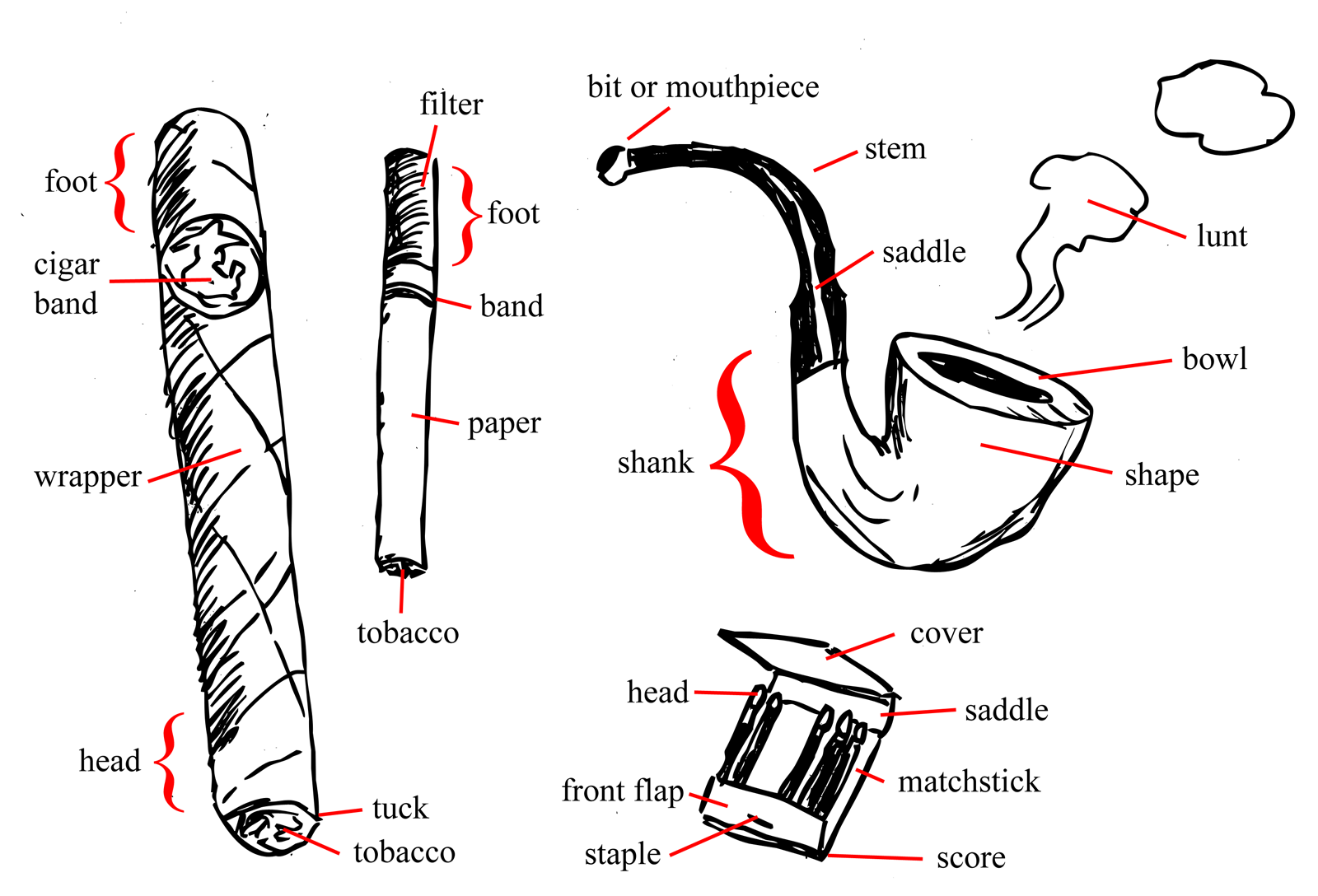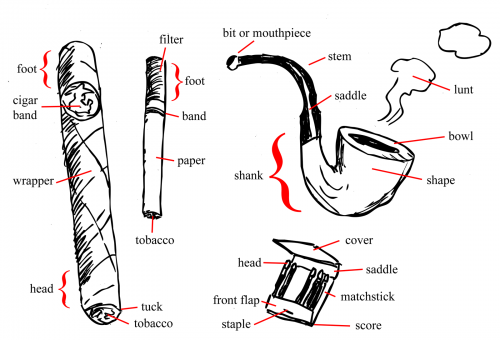So your play needs cigarettes. Aaaah.
In most venues by now, real cigarette smoking is viewed as the next plague. The fear is that lighting a single cigarette for a few seconds in a large, well-ventilated theater, is worse than the constant outpouring of pollution from 250 million cars, 600 coal power plants, and every other industrial process. But I digress.
Even herbal cigarettes are becoming banned in many places; this is due to health reasons, moral hesitance, or simply for the fire hazard. Even if they are permitted, many people dislike them for their “marijuana-y” smell and horrible taste. Enter “e-cigarettes”.
First introduced in 2003, electronic cigarettes (“e-cigarettes”) quickly became popular for theatres stuck between the rock of smoking bans and the hard place of artistic freedom. They completely eliminate the hazard of second-hand smoke (the “smoke” is actually just water vapor), and seem to pose minimal risk to the user. However, because they are so new, our knowledge of them and their effects is in constant flux; a lot has changed just in this past year. Just last week, the FDA was blocked from stopping e-cigarette shipments to the United States. This means that, for now at least, they remain unregulated but legal to use here.
The FDA has been railing against electronic cigarettes since last July, when they released a study. What’s important to take away from their results is not that e-cigarettes are necessarily dangerous, but that their potential dangers are unstudied, and without regulation their ingredients may not be fully disclosed. In one article, we find that:
- All but one of the cartridges was marked as having no nicotine when they actually contained the addictive substance.
- The cartridges that were marked as having low, medium, or high amounts of nicotine actually have varying amounts of nicotine.
- One of the cartridges tested positive for having a toxic antifreeze ingredient, diethylene glycol.
- The devices were emitting “tobacco-specific nitrosamines which are human carcinogens.â€
- The devices were also emitting tobacco-specific impurities that are suspected of being harmful to humans.
(Health News, FDA Warns Against E-Cigarettes)
When we use e-cigarettes, we choose the “zero-nicotine” cartridges. What’s troubling in this report is that even these might contain nicotine. The danger is not necessarily the nicotine; nicotine is not one of the ingredients in cigarettes which causes cancer, and is not toxic in the amount found in cigarettes (read more about the complicated toxicology of nicotine). The danger comes from the possibility of mislabeled products. An actor on the nicotine patch (or other smoking cessation therapy involving nicotine) who smokes an e-cigarette under the false assumption that it contains no nicotine can overdose. I overdosed when I was on the patch, and it was painful, ugly, and frightening. Secondly, mislabeling the amount of one ingredient draws concern that other, more dangerous ingredients, are left unlisted.
A second article from last July adds:
Scott Ceretta is a respiratory therapist and works with the American Lung Association in Tucson. He explains, “First off is the safety. The manufacturer of this product claim that it’s safe and only has nicotine and doesn’t have the harmful chemicals found in tobacco. But, again, we’ve been lied to before.” Dr. Scott Leischow of the Arizona Cancer Center in Tucson says it’s likely e-cigarettes are less harmful than cigarettes with tobacco. But, he adds they haven’t been adequately tested here. Dr. Leischow tells News 4, “We don’t know, this propylene glycol that the nicotine is mixed in, we don’t know what happens when a person inhales that over a long period of time.”
(KVOA News 4, Investigating the health of e-cigarettes)
Again, it’s not that e-cigarettes are dangerous; but a lack of testing so far cannot prove what effects they have on the human body. You can read the full report of FDA analysis (pdf) for more information which includes a diagram of how an e-cigarette works. They tested the “Njoy e-cigarette” and “Smoking Everywhere Electronic Cigarette” brands.
In response to the FDA’s study, Exponent Health Sciences carried out their own analysis. They found a number of flaws in the study, mostly relating to the amounts of chemicals not listed in the ingredients, and how they relate to FDA-approved nicotine replacement therapy products. In some cases, the disparities between the listed and actual ingredients which caused the FDA such great concern was less severe than in products they actually approve of. Exponent was commissioned by the Njoy company, but the two companies are separate and discrete entities.
Let’s assume that the labels are correct. How does propylene glycol affect us? Here is an article from 1942:
Propylene glycol is harmless to man when swallowed or injected into the veins. It is also harmless to mice who have breathed it for long periods. But medical science is cautious—there was still a remote chance that glycol might accumulate harmfully in the erect human lungs which, unlike those of mice, do not drain themselves. So last June Dr. Robertson began studying the effect of glycol vapor on monkeys imported from the University of Puerto Rico’s School of Tropical Medicine. So far, after many months’ exposure to the vapor, the monkeys are happy and fatter than ever.
(Time Magazine, Medicine: Air Germicide)
We should of course be skeptical of a science article from 1942. DNA had not even been discovered yet, and cigarettes were still endorsed by doctors. Still, propylene glycol is used in many theatrical fog machines and hazers, and the dangers are known and their use regulated by Actors’ Equity. The concern over propylene glycol in e-cigarettes was described in ACTS FACTS last August after the FDA’s report was released:
Our concern is that, like the theatrical fog machines which also contain propylene glycol, this chemical will dissociate into toxic chemicals do when the e-cigarette heats or burns them. Since good actors can carry off the deception without inhaling, e-cigs still appear safer than real cigarettes for both the smokers and others on stage.
(ACTS FACTS, Monona Rossol, Editor. August 2009. www.artscraftstheatersafety.org)
They then return to my earlier point about accurate labeling:
But these points are moot if Chinese manufacturers cannot assure us that they can keep diethylene glycol and carcinogens out of e-cigs. At this point we have no advice and await further data.
(ibid.)
So Equity, for the most part allows them at this point (though some say they’ve had problems).
Since the rules seem to be changing so fast these days, and local laws differ vastly, you can’t be assured of anything. Look at the legal status of e-cigarettes around the world, and you can see how the USA is one of the few countries that still allows them. Also, understand that that list is probably out of date already. Before you drop a hundred or so dollars on an e-cigarette system, check with both your Actors’ Equity representative and production manager whether they are still allowed in your theater for your production. Make sure your actor understands that inhalation is not necessary for the effect and should be limited or avoided as much as possible. Finally, try to find the most reputable brand you can to avoid the problem of dishonest labeling. You should do all this the first time someone mentions they’d like to have one of the characters smoking on stage. For now, as long as we have fog machines, pyrotechnics, flying rigs, stage firearms and other dangerous devices on stage, I believe the monitored use of e-cigarettes can be safely regulated.


